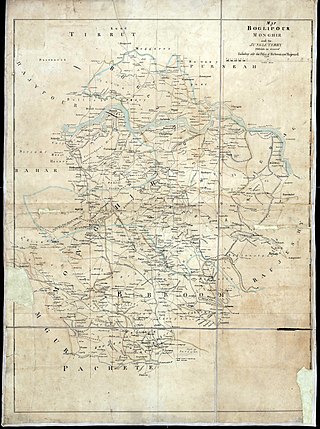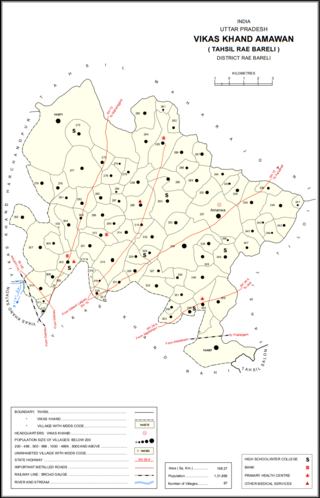
A zamindar in the Indian subcontinent was an autonomous or semi-autonomous ruler of a province. The term itself came into use during the reign of Mughals and later the British had begun using it as a native synonym for "estate". The term means landowner in Persian. They were typically hereditary, and held the right to collect tax on behalf of imperial courts or for military purposes.

Giridih is headquarters of the Giridih district of Jharkhand state, India. The city of Giridih is known for its industrial and health sectors, as well as its scenery. Giridih houses the Giridih Coalfield which is one of the oldest coalfields to be worked in India. Giridih is one of the six Data Processing Centres of Data Processing Division (DPD) of National Sample Survey Office (NSSO). Before 1972, Giridih was part of Hazaribagh district.

Giridih district is one of the twenty-four districts of Jharkhand state, India, and Giridih is the administrative headquarters of this district. As of 2011 it is the third most populous district of Jharkhand, after Ranchi and Dhanbad.

Bikrampur was a pargana situated 19 kilometres (12 mi) south of Dhaka, the modern capital city of Bangladesh. In the present day, it is known as the Munshiganj District of Bangladesh. It is a historic region in Bengal and was a part of the Bhawal Estate.

The Bardhaman Raj, also known as Burdwan Raj, was a zamindari Raja estate that flourished from about 1657 to 1955 in the Indian state of West Bengal. Maharaja Sangam Rai Kapoor, a Khatri from Kotli, Punjab, who was the first member of the family to settle in Bardhaman, was the original founder of the house of Bardhaman, whereas his grandson Abu Rai, during whose time the zamindari started flourishing, is considered to be the patriarch of the Bardhaman Raj family.
Parbati Sankar Roy Choudhury, (1853–1918) was the zamindar of Teota and a philanthropic landholder.

Bhawal Estate was the second largest zamindari in Bengal until it was abolished according to East Bengal State Acquisition and Tenancy Act of 1950.
Kaili is an Austronesian dialect cluster of the Celebic branch, and is one of the principal languages of Central Sulawesi. The heartland of the Kaili area is the broad Palu River valley which stretches southward from Central Sulawesi's capital city, Palu. Kaili is also spoken in the mountains which rise on both sides of this valley, and along the coasts of the Makassar Strait and the Gulf of Tomini.

Zamindars of Natore were influential aristocratic Bengali Zamindars, who owned large estates in what is today Natore District in Bangladesh .
Kharagdiha is a village in the Jamua CD block in the Khori Mahua subdivision of the Giridih district in the Indian state of Jharkhand. It had been known as Curruckdea or Curruckdeah during the British Raj.

The Nagvanshis of Chotanagpur, also known as the Khokhra chieftaincy, was an Indian dynasty which ruled the parts of Chota Nagpur plateau region during much of ancient, medieval and modern period. Phani Mukut Rai is considered the first king of dynasty claim to be son of Pundrika Naga, a mythical Naga. Lal Chintamani Sharan Nath Shahdeo (1931–2014) was last ruling king of the dynasty, until the estate was merged to the Republic of India.
Mankar is a village in Galsi I CD Block in Bardhaman Sadar North subdivision of Purba Bardhaman district in the state of West Bengal, India.

Kharagpur Raj was a prominent chieftaincy, founded in the early 16th century in Bihar situated mainly in modern-day Munger district. They were notable for being one of the few chieftaincies in Bihar to convert to Islam and many of the rulers became firm allies of the Mughal authorities. At its peak, the Kharagpur Raj encompassed parts of the modern-day districts of Munger, Bhagalpur, Jamui, Lakhisarai, Godda and Deoghar. Due to its size, the Privy Council compared it with the Kingdom of Sardinia.

Vishwanath Shahdeo was the king of the Barkagarh estate and a rebel in the Indian rebellion of 1857. In 1855, he declared himself independent and defeated British forces in Hatia. He led rebels of Ramgarh Battalion in 1857. But defeated by Company forces with the help of king of Pithoria Jagatpal Singh. He was eventually caught and was hung from a tree along with his accomplices in 1858.
The House of Baghoch commonly known as Baghochia was the ruling dynasty of Hathwa Raj and Bansgaon Estate until 1947 when the state was abolished and merged into the newly formed Union of India. The House takes its name from Baghoch and Bharhichowra, the ancient seats of the rulers of Hathwa Raj. The name Baghauch also may have been associated with the clan from totemistic stage as the name makes reference to Bagh (Tiger) as the clans totem. Based on the totem the name of the first capital was Baghauch. They are a sub-group of the Vats gotra Bhumihar Brahmin The founder of the dynasty was Raja Bir Sen who played an instrumental role in the invasion of the Sakyas by the Kosla Maharaj Virudhaka in 6th century BCE, and it is in the aftermath that Raja Bir Sen got part of the newly invaded country as his Raj. This makes the Baghochia dynasty one of the oldest and the longest ruling dynasty in the world and also a clan with one of the deepest genealogy.
Ghatwali was a feudal tenure/jagir for quasi-military services, only found in the district of Santhal Parganas and some parts of Munger. The ruling chiefs of these jagir were known as Ghatwals. They were responsible for maintaining safety, security, and law enforcement in their estate using a force of archers and Berkandazes. The Deoghar subdivision consisted of 53 Ghatwalis among which the largest were Rohini, Pathrol, Baman-ganwa, Kukraha, Garsara, Teor and Burhe. The Deoghar ghatwali were formed under the Birbhum Raj in the 18th century to defend against the invasion of Marathas and neighbouring rulers. Kharna estate was another prominent ghatwali in Kharagpur Raj. The Kharagdiha gadis were earlier on ghatwali tenure, but when Captain Cammec found these Malik of the gadis prominent in their country, these gadis were permanently settled slowly after 1793. The ghatwals of Kharagdiha became the Zamindars and Rulers of their respective estates. Some of the prominent Khargdiha gadis were Gadi Palganj, Koderma, Goranjee, Gadi Ledo and Gadi Sirsia.
Purenw or Pureon is a large village located in Kerakat Tehsil of Jaunpur, Uttar Pradesh, India with total 765 families residing. The Purenw village has population of 5054 of which 2462 are males while 2592 are females as per Population Census 2011. As per constitution of India and Panchyati Raaj Act, Purenw village is administrated by Sarpanch who is elected representative of village.
Krishnaut or Kishnaut Ahir is a ruling clan of the Yadav (Ahir) caste found in Bihar, Jharkhand and Nepal. The term Krishnaut denotes their descent from Lord Krishna.

Hardaspur is a village in Amawan block of Rae Bareli district, Uttar Pradesh, India. As of 2011, its population is 2,974, in 570 households. It has 3 primary schools and one small clinic.

The zamindars of Mahipur were a Bengali aristocratic family of feudal landowners. The zamindari estate encompassed the Chakla of Qazirhat under the Cooch Behar State since the Mughal period. Although their aristocratic status was lost with the East Bengal State Acquisition and Tenancy Act of 1950, the Mahipur estate remains an important part of the history of Rangpur and belongs to one of the eighteen ancient zamindar families of Rangpur. The zamindari palace was lost as a result of flooding from the Teesta River, although the mosque, cemetery, polished reservoir and large draw-well can still be seen today.












